In a Hurry? Check Out Our Video on Choosing a New Air Conditioner!
How Does an Air Conditioner Work?
This section isn't mandatory reading but sometimes it helps to understand how a product works in order to feel more confident about your purchase!
The biggest misconception: Air conditioners aren't "adding coldness" to the air. They are removing heat.
Basically, it's science magic. Your air conditioner contains a chemical called a "refrigerant." Refrigerants "boil" (turn into a gas) at a much lower temperature than water - around 40-50°F! In a typical window air conditioner, this chemical is moved around from the indoor-facing side to the outdoor-facing side and back again. It absorbs heat from the indoors and releases that heat by changing from a liquid to a gas and back again. By constantly transporting heat energy from inside to release it outside, your room will feel cooler. (Bonus fact: Your refrigerator works the same way!)
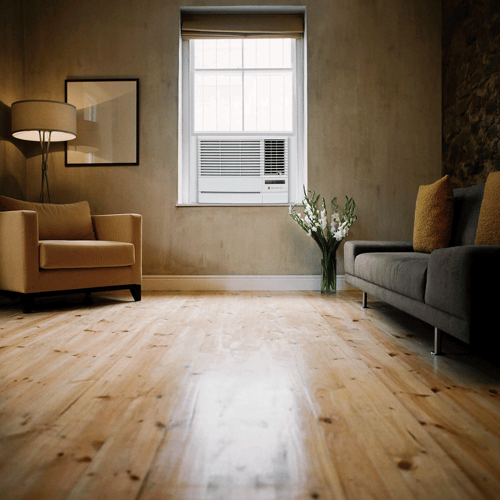
The "outside side" of your AC contains the compressor and the condenser. The room-facing side contains the evaporator. The compressor pulls the refrigerant from the evaporator in the form of a gas, smooshes (compresses) it into a hot, high-pressure gas, and then the condenser releases the heat into the outside air. When the refrigerant is cool enough, it becomes a liquid again and returns to the evaporator, where it absorbs heat from the room and "boils" into a gas to re-enter the compressor again.
All air conditioners work this way - window and wall fit air conditioners unify the evaporator, compressor, and condenser, while central air and ductless mini split air conditioners put the compressor and condenser outdoors on a roof or at ground-level and feed the refrigerant back and forth from indoors to outdoors.
Have you ever wondered why air conditioners drip? Dehumidifying the air is another benefit of air conditioners - You know how people say that "dry heat" isn't as bad? They're not just taunting those of us who live through miserably humid summers... it's because in a drier environment our sweat can do what it's supposed to and actually evaporate off of our skin to cool us. The first air conditioner designed in 1902 was designed for humidity control!
Anyway, that's a basic look at how air conditioners work. Now let's get into the nitty-gritty of buying one!
What Size of Air Conditioner Do You Need?
Air conditioner size or "power" is found in the BTU rating, which is technically "BTU per hour." A "British Thermal Unit" is a unit of heat - so BTU per hour measures how much heat an air conditioner can remove from the air in an hour.
There are a lot of factors that may impact how quickly your room heats up during the day and thus how powerful of an air conditioner you will need. Consider factors such as...
-
The size of the room
-
Which floor the room is on
-
Sun exposure throughout the day
-
The number of people in the room
-
Equipment and machinery in the room that put off heat (such as computers or a refrigerator)
-
Whether the room is part of an open floor plan
An air conditioner that is too small won't keep up with the room's cooling needs, and a model that's too large will not run long enough to pull moisture from the room, so the room will feel damp or clammy.
Energy Star offers some additional guidelines:
-
If the room is heavily shaded, reduce capacity by 10%
-
If the room is very sunny, increase capacity by 10%
-
If more than 2 people regularly occupy the room, add 600 BTUs for each additional person
-
If the unit is used in a kitchen, increase capacity by 4,000 BTUs
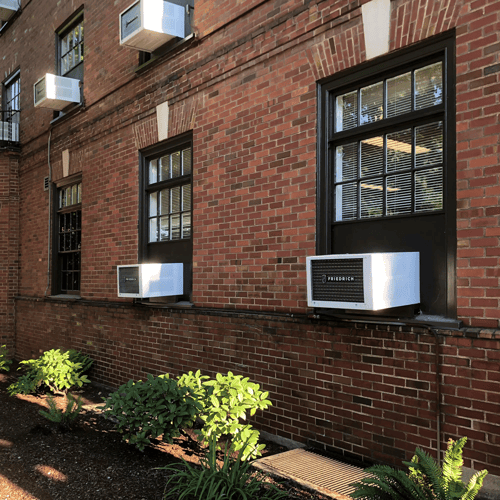
For the average home, this basic table will help you decide what size of air conditioner to buy - but the factors listed above could add another 2,000-3,000 BTUs needed to adequately keep the area cool.
| Examples of Room Types | Room Size (Square Feet) | BTUs Required |
| Bedroom or home office | 100-150 | 5,000 |
| 150-250 | 6,000 | |
| 250-350 | 8,000 | |
| Master bedroom or den | 350-450 | 10,000 |
| Living room or open floor plan | 450-550 | 12,000 |
| 550-700 | 14,000 | |
| 700-1,000 | 15,000-18,000 |
This should give you a good idea of the size of air conditioner you need, but we always recommend speaking with a professional to help you with your decision. If you're considering a central air or ductless split system, you should always have a professional come to your home to provide an estimate!
Types of Air Conditioners
Window Air Conditioners
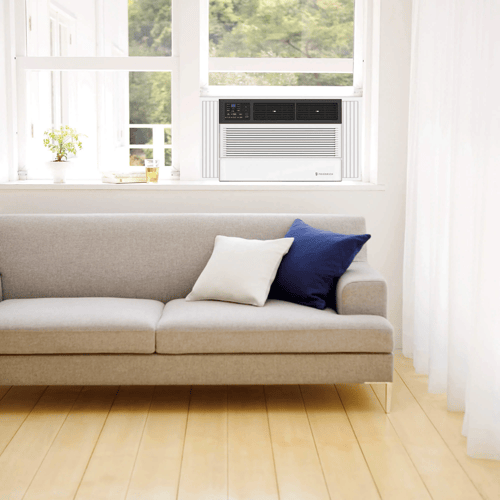
The most common type of window air conditioner is designed to fit in double hung windows and comes with accessory pieces to fill the extra room on either side of the window and secure the unit so it won't fall out. These models are incredibly popular due to their low cost and the ease of setup and installation. They come in sizes from 5,000 BTUs to about 18,000 BTUs.
When it comes to price...
-
Small models (5,000-6,500 BTU): ~$150-$250
-
Medium models (7,000-8,200 BTU): ~$200-$400
-
Large models (9,800-12,500 BTU): ~$350-$600
- XL models (11,000+ BTU): ~$700-$1,000+
Window air conditioners can be basic or come with cool features like smartphone connectivity. They are a great option if you want something to keep you cool in summer and aren't looking for a permanent installation.
Slider casement air conditioners have a tall, narrow shape. They are designed to fit in a slider window and can be adapted to other odd sizes of double hung windows and crank-out windows. There aren't a ton of options available and they are typically $400-$600.
Window Air Conditioner Pros:
-
Easy to set up/DIY
-
Come in a range of sizes to suit small to large rooms
-
Relatively inexpensive
- Relatively efficient
Window Air Conditioner Cons:
-
Some require support brackets to sit securely in window (you will have to drill holes into the frame)
-
Not compatible with all window types and sizes
- Not the most aesthetically pleasing, especially if they're in a window on the front of a home or block a nice view
Wall Fit Air Conditioners
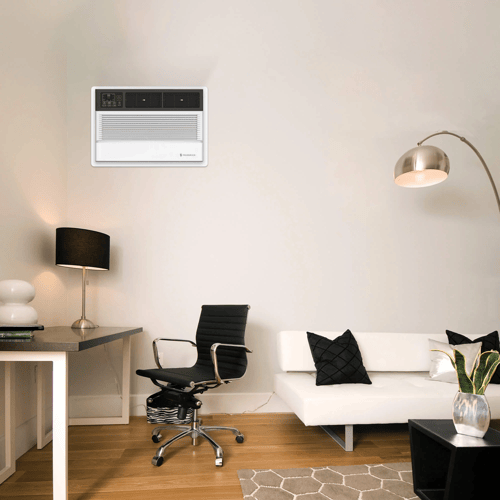
Wall fit air conditioners are designed to be installed in a metal sleeve that is installed in the wall. The sleeve is usually completely enclosed on the sides and top with no louvers (slats for ventilation). These models breathe and exhaust from the rear.
Wall fit models will usually fit or adapt to existing sleeves in apartment buildings and commercial buildings. If you are considering installing cutting a hole in the wall to install such a unit, keep in mind that the sleeve is usually sold separately.
Some slide out chassis air conditioners can be installed into a window or a wall. These models vent out the sides and back, while a through-the-wall model only vents through the back. Window and wall fit air conditioners are not interchangeable due to this difference in venting.
Wall Fit Air Conditioner Pros:
-
More efficient cooling thanks to airtight seal in the room
-
Come in higher cooling capacities than window units
-
Won't block view through window
- Often quieter than window units
-
Permanent installation rather than having to put it in each summer
Wall Fit Air Conditioner Cons:
-
More difficult to install than window units - may require a professional
-
More labor intensive installation
- Permanent installation may not be a good fit for some homes and climates
Portable Air Conditioners
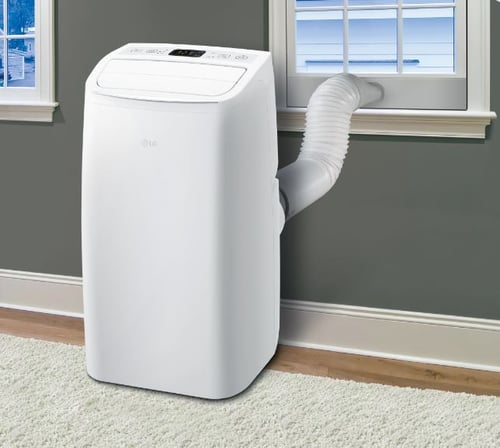
Portable air conditioners are designed to be moved from room to room in the home and can be a good choice if your windows don't allow for the installation of typical window air conditioners or slider casement models. They range in price from around $300 to $700.
Portable models require you to install one or two hoses out of a window or door, and they come with the accessories needed to do so. They work best if installed correctly and according to the instructions. Two hose models are uncommon but work better than single hose models. BTU ratings range from 9,000 to 15,500 BTU, but new BTU ratings introduced by the Department of Energy in 2018 will show a lower number. This is mainly because...
-
Portable units pull in air from the room and exhaust hot air to the outside. This creates a pressure difference between indoors and outdoors, so (hot) outdoor air will find a way in to equalize the pressure.
-
The parts of the air conditioner that get hot are inside the room, unlike a window or wall fit model, so some heat is exhausted back into the room this way as well.
We recommend window units if they are an option since portable models are less efficient when it comes to cooling power and energy usage - they can use 50% more energy than a window unit with the same BTU rating! Read more about portable vs window ACs here.
Portable Air Conditioner Pros:
-
Can roll from room to room on casters (but can still be pretty heavy)
-
An option when a casement or window air conditioner won't work
- Won't block view through a window as much as a window model
Portable Air Conditioner Cons:
-
Take up floor space
-
Less efficient design means it heats some of the air in the room and draws in hot air from the outside
-
Require more power to cool the same amount as a window unit
- Noisier operation than a window unit
Ductless Mini Split Air Conditioners
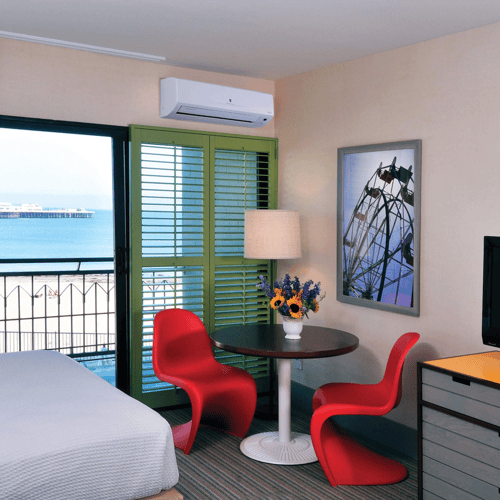
A split air conditioner system puts the noisy parts of the air conditioner outside (namely, the condenser). It is installed on or near the exterior wall of the room you want to cool, with the "air handler" containing the cooling coil, a blower, and an air filter is mounted on a wall, ceiling, or even the floor.
The ductless mini split air conditioner got its name in comparison to traditional central air conditioning installations, which require ductwork and are designed for whole-house cooling (so, they're not "mini!"). You can install a ductless mini split air conditioner in just one room or a few rooms in your home - one outside compressor can serve up to four inside air handlers. Models with heat pumps can be used to heat a room as well as cool it. The indoor and outdoor parts are connected by small suction lines and power lines, nothing more!
Ductless Mini Split Pros:
-
Less expensive than central air
-
Very quiet indoors and out compared to window air conditioners and central air
-
Can install multi-zone systems to cool multiple rooms
-
Easy installation with no electrical work required inside the home (but must be installed by a licensed HVAC professional - electrical work will be required on the exterior and into your electric panel)
Ductless Mini Split Cons:
-
Up-front costs can be slightly higher than a central system if installing multiple mini split units
-
Less aesthetically pleasing than "hidden" central air options that are little more than a vent in the floor or ceiling
Central Air Conditioning
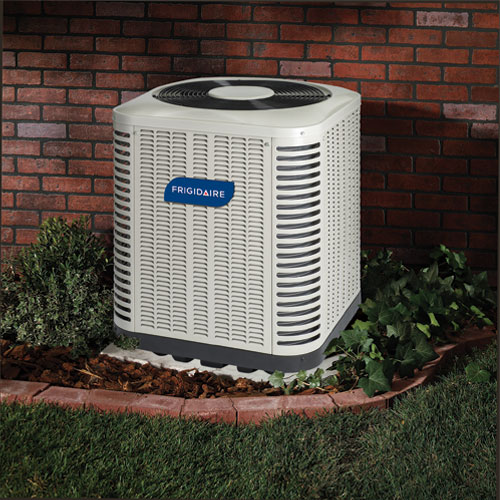
Central air conditioning may be a good choice for large homes, in particular newer homes that are airtight to reduce cooling losses. This system consists of a duct network throughout your home, connected to an indoor air handler unit and fan system that is in turn connected to an outdoor unit. This is an unobtrusive home cooling solution that's easy to operate (no need to adjust multiple zones throughout your home like a ductless mini split system).
One issue with central air conditioning is that you may find that, just like with a central heating system, some rooms end up warmer or cooler than others. Additionally, you're going to be cooling the entire home evenly, including rooms you may not be using. Some people choose to augment a whole-home system with a ductless system - installing the smaller ductless units in warmer or more-used rooms.
Central air also is not as efficient as mini splits because of the cooling losses due to the air needing to travel through ductwork. Choosing a trusted HVAC professional to install this ductwork is crucial!
High velocity air conditioners are much smaller than a traditional system and can be used with smaller vents and ducts (just 2-4" circumference), but they can be noisier than traditional central air and some people dislike the intensity of the cold air coming out of the vents.
Central Air Pros:
-
Ideal for cooling large rooms and large homes
-
"Centralized" solution if you don't want to adjust individual zones throughout your home
- May have a lower up-front price than ductless mini split systems (not including installation)
Central Air Cons:
-
Require routine maintenance and regular cleaning
-
Installing ductwork throughout your home can be costly
-
Labor-intensive installation process - takes up to a week
- Higher energy costs
Terms & Features - Options to Consider
Air Conditioning Terms
BTU Rating
BTU stands for "British Thermal Unit." By definition, air conditioning is the removal of heat. The BTU rating is a measure of energy that relates to the amount of heat that an air conditioner can remove from the air in an hour.
EER Rating
The "Energy Efficiency Ratio" refers to the number of BTUs that an air conditioner will produce per watt of electricity used (BTU-hours/watts). The higher the EER, the more efficient the air conditioner is and the lower the cost of operation.
CEER Rating
This is a new standard introduced by the DOE (Department of Energy) in 2014 for window air conditioners that takes into account the standby power used when the unit is not running as well as the energy consumed during use. Read more about energy efficient ACs here.
HVAC
HVAC, or H-VAC, stands for "Heating, Ventilation, and Air Conditioning." It refers to the industry and trade of installing and repairing systems for moving air. A licensed HVAC contractor can install central heating and air conditioning systems, split systems, and other related products.
SACC Rating
The "Seasonally Adjusted Cooling Capacity" is a BTU/hour rating that shows the weighted average performance of a unit across a range of test conditions. This is applied only to portable air conditioners, as it takes their performance and adjusts for factors like infiltrated air and duct heat transfer. This new standard was introduced in 2018 - models made before 2017 were tested under the ASHRAE standard that resulted in a higher cooling capacity since it did not take these factors into account. The SACC ratings are more accurate and better account for the efficiency losses of portable AC units.
SEER Rating
The "Seasonal Energy Efficiency Ratio" is used with central air and split system units and heat pump equipment. It is a measurement of the efficiency of the equipment and the cost of operation over the entire season.
Slide Out Chassis
The chassis is the frame of the air conditioner. Many models have a "fixed chassis" that is joined to the body of the air conditioner. With a slide out chassis, such as those found on many Friedrich AC models, installation is easier since you can separate the chassis and frame for installing in a wall or window.
Ton
This term is also related to an AC unit's cooling capacity. Basically, one ton = 12,000 BTUs. This term is most often used in the HVAC business and is most relevant to the powerful central air systems. A 5 ton system would be equal to 60,000 BTUs.
Air Conditioner Features
Adjustable Louvers/Directional Airflow Vents
Especially important if you're installing a unit in a corner, adjustable louvers allow you to direct the air at different angles, similar to a car air vent. Some models also have louvers that swing back and forth automatically to circulate cool air throughout the room.
Control Panels
Features like digital temperature readouts and clearly labeled buttons will make your air conditioner easier to use. Some models also come with remote controls.
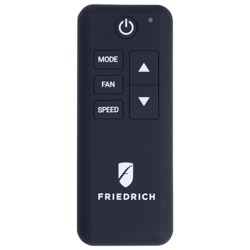
Heat Pump
Heat pump air conditioners can be used to heat or cool a room. They can reverse the cooling cycle: they can remove heat from the air inside the home and send it outside in the summer, and in winter they can add heat to the outside air and send it inside.
Modes & Options
Look for features like "sleep mode," dehumidify mode, fan-only mode, and energy saver modes if you want to use your air conditioner often. A "fresh air intake" mode will pull air in from the outside without cooling it if you need a breeze or to air out the room.
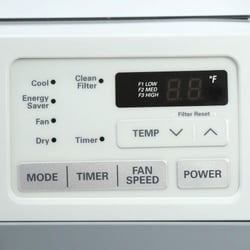
Temperature Sensor Readouts
Some models can tell you the room's current temperature rather than just the temperature at which you've set the unit.
Timers/Efficiency Aids
AC units with timers can be set to cycle on and off. For example, you could set it to turn on an hour before you leave from work. Some air conditioners now come with smart connectivity features so you can turn it on or off from your smartphone!
Removable Filter
Keeping your air conditioner's filter clean helps it work better and prolongs its life. Check that the air filter is easy to remove. Some units also come with a filter cleaning alert on the control panel. Most window, wall, and ductless mini split units come with reusable filters that you can wash clean and pop back into the unit. Central air units typically have disposable filters that need to be replaced periodically.

How to Choose the Right Type of Air Conditioner
Seasonal Solutions - Window Air Conditioners vs Portable Air Conditioners
Basically, any air conditioner has a "cool side" and a "hot side." The cool side faces into the room or is placed in your house, while the hot side should be facing outside your window or completely outside in the case of split systems. The "hot side" is also the noisier side because it has more machinery magic going on, while the "cool side" is quieter. Air conditioners work by absorbing heat energy from the room, with one exception: portable air conditioners.
Portable air conditioner models are the least efficient and loudest option, so they should be avoided if a window unit or other option is possible. They suck in air from the room to cool it and then exhaust the hot air through a tube that attaches to your window. However, when you're moving air from inside to outside, not just heat, this causes a pressure difference between the amount of air inside and the amount outside. As a result, that hot summer air is going to be pulled into your house one way or another to equalize the pressure. That's why many portable air conditioners now come with two BTU ratings - the lower BTU rating from the US DOE takes these pressure changes into account.
So portable models are less efficient when it comes to cooling ability, and on top of that they require a lot more power to do the same job as a window unit. They also tend to be louder than a window unit because all of the "noisy parts" are inside rather than sticking out of your window!
So if you're trying to decide between a window unit vs a portable air conditioner, choose the window unit if possible! You'll have better cooling results with less energy usage, and a quieter model overall.
Window air conditioners are a go-to for many people. They're cost-effective, easy to install, and mainstream brands are pretty reliable. They're the perfect solution to hot summer days!
Year-Round/Permanent Installations - Wall Fit vs Ductless Mini Splits vs Central Air
You may be debating a through-the-wall air conditioner vs a ductless mini split, or a ductless system vs central air. We'll break down the debate for you to help you decide!
| Wall Fit Air Conditioner | Ductless Mini Split System |
| Noisier (although quieter than a typical window uni) | Quieter since the "noisy parts" are outside of the home |
| Need to cut a large hole in the wall through to the exterior to install the sleeve | Only small cutouts are needed for the suction lines and power lines |
| Easier to install on upper floors | Can be more difficult to connect to the compressor outdoors if installing on an upper floor |
| Up-front cost starts at around $500 (8,000 BTU models) up to $1,300 (14,000 BTU models) | Up-front cost is $1,500-$2,000 per ton of cooling capacity (1 ton = 12,000 BTUs) |
| Can't connect multiple units for "multi-zone cooling" | Can connect multiple units to a single compressor for "multi-zone cooling" |
| DIY installation is possible if you have the tools and expertise to cut and frame a hole in your wall | Should most likely be installed by a licensed HVAC professional (or risk voiding the warranty) |
| Less energy efficient than a split system | More energy efficient than a window or through-the-wall unit |
If you're considering a window air conditioner vs a ductless mini split, many of the points made above remain relevant - but with window units, up-front costs are even lower and installation is fast and easy to DIY. They can be slightly less energy efficient than through-the-wall systems since the area around the unit is not sealed.
What about ductless mini splits vs central air? You're probably interested in comparing these systems because you want a whole-house cooling solution and don't have ductwork already installed. Warranties are usually longer on central air systems but don't include the ductwork. You can also install a central air system and supplement it with ductless units in warmer rooms.
| Ductless Mini Split System | Central Air Conditioning |
| "Minimally invasive" installation - Only takes a couple of days to install throughout a home, a good fit if you have a historic home and no room for ductwork | Installing ductwork is time-consuming and creates a lot of construction mess |
| Unit is placed on the wall, ceiling, or at floor-level - Not aesthetically appealing | Minimally visible, requires vents placed throughout the home rather than bulky evaporator units |
| Allows for a zoning system - Tailor the temperature to each room or area's cooling needs (as long as you don't lose the remotes!) | Whole-house cooling controlled from a central thermostat - Some rooms may not cool down evenly |
| Easiest to implement in homes that are 2,000 square feet or less | Most effective in large homes of 2,500 square feet and up |
| More energy efficient since there is no air delivery through ducts (lower utility bills) | Even the best ductwork will have some heat exchange/cooling losses as it travels through your home |
| Generally quieter when in use (ask for decibel rating where possible) | Generally louder when in use (ask for decibel rating where possible) |
| Routine maintenance focuses on checking the outdoor unit and the air filters of the individual indoor units | Routine maintenance includes regular ductwork cleaning and inspection to prevent efficiency losses and the spread of indoor pollutants (dust, mold, etc) through the ducts |
What to Know When You Go to the Store
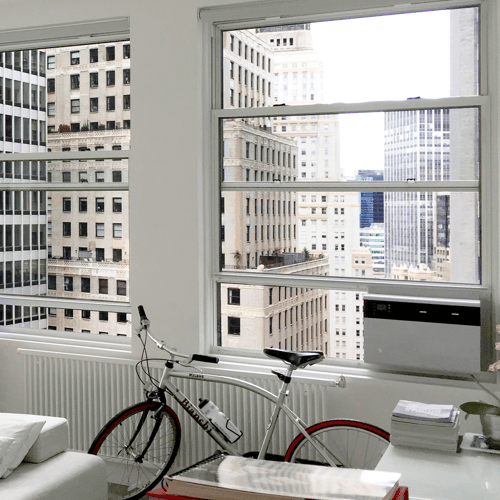
Before you go shopping, you should decide what your budget is for the purchase.
If you're considering a window AC unit, you should know the following:
-
The type of window you have (Double hung, awning, crank-out, sliding, etc)
-
The height and width of the window opening at the narrowest points
-
The window materials (Vinyl covered replacement window, wooden window, metal window)
-
The layout of the area to be cooled
- Where the AC unit will be installed - e.g., if it's in a corner you'll want fans pointed outwards towards the middle of the room
If you're installing or replacing a wall fit model, you should know the following:
-
The dimensions of your current wall sleeve inside (height, width, and estimated depth)
-
Whether your current wall sleeve is solid or has louvers on the sides and top
-
The BTUs of your current unit
-
The size of the area it is cooling
-
The voltage of the outlet that your current unit is plugged into
Consult with a professional if you're considering central air or ductless split air conditioning. Know the area of your home that you want to cool, and how much you are willing to spend to get the job done.
Final Thoughts
Now it's time to head into the store and test out the different working units if you can! When it comes to comparing different models, keep in mind...
-
Energy Efficiency: Energy Star rated air conditioners will save you money. In central air conditioning equipment, look for a SEER rating of 16 or higher. For ductless split systems, look for a SEER rating of 18 or higher and an HSPF rating of 9 or higher.
-
Noise Level: Most window and wall fit air conditioners don't have a decibel rating listed, and the noise level of an AC unit can be a big deal. Go to a store where they are hooked up live so you can turn them on and hear the differences.
-
Central air is usually very quiet because the moving parts are not located in the living area, but you should ask about the condenser's noise level, in particular if it is installed near a deck or other outside living area.
-
Ductless split conditioners often have decibel ratings that you can get from your estimator or online.
-
-
Warranty: Warranties vary by brand, and this information is available in literature, online, or from your salesperson or estimator. Brands like Friedrich, for example, offer five years parts and labor on the sealed refrigerant system, the heart of your AC unit.
We carry brands like Frigidaire, Friedrich, LG, and GE Appliances - Mainstay appliance brands and specialty brands are good options to consider since they often have better reliability and warranties than "mystery" brands that may be selling AC units for cheap. Frigidaire and GE offer a range of budget models, and Friedrich is a specialty brand that makes consumer and commercial AC products that are quiet but often at a higher price point.
Now you can shop with confidence and stay cool this summer and for many summers to come!
Like what you see here? Download the free PDF version of this buying guide and take it with you anywhere!



